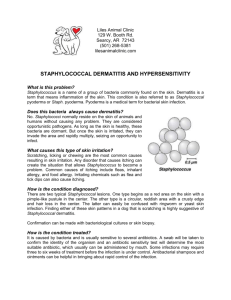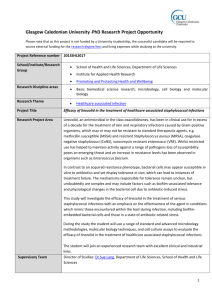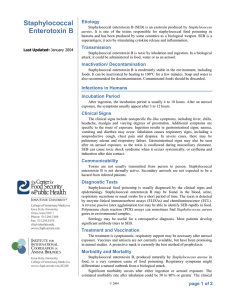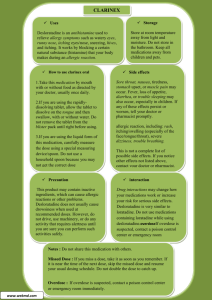Staph. Dermatitis
advertisement
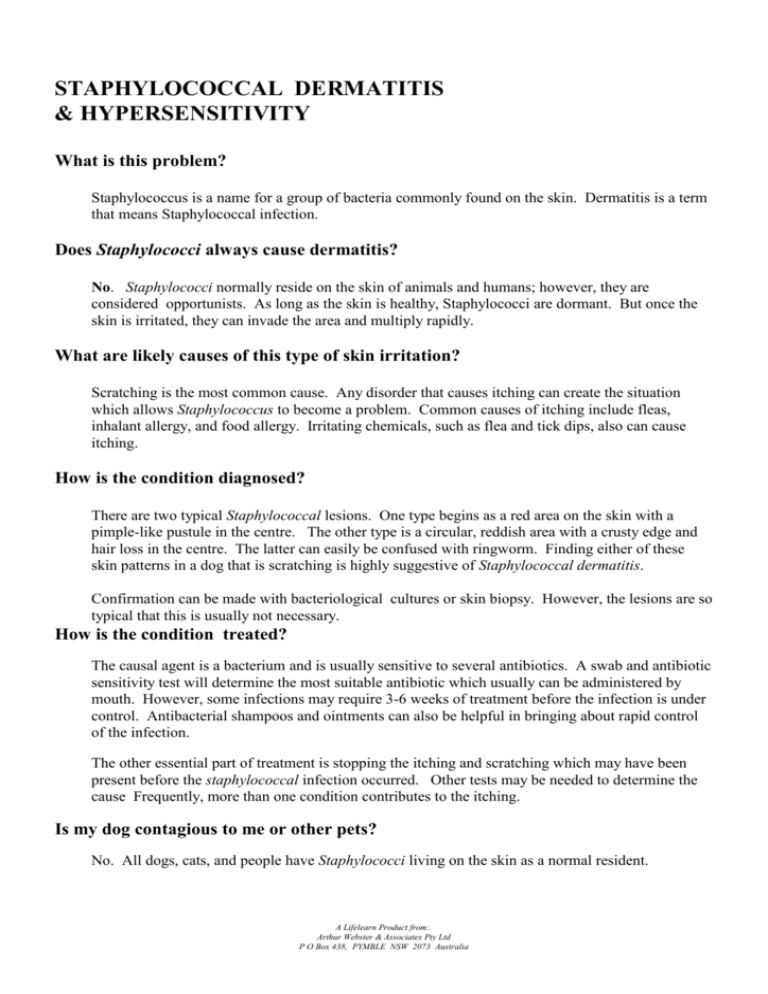
STAPHYLOCOCCAL DERMATITIS & HYPERSENSITIVITY What is this problem? Staphylococcus is a name for a group of bacteria commonly found on the skin. Dermatitis is a term that means Staphylococcal infection. Does Staphylococci always cause dermatitis? No. Staphylococci normally reside on the skin of animals and humans; however, they are considered opportunists. As long as the skin is healthy, Staphylococci are dormant. But once the skin is irritated, they can invade the area and multiply rapidly. What are likely causes of this type of skin irritation? Scratching is the most common cause. Any disorder that causes itching can create the situation which allows Staphylococcus to become a problem. Common causes of itching include fleas, inhalant allergy, and food allergy. Irritating chemicals, such as flea and tick dips, also can cause itching. How is the condition diagnosed? There are two typical Staphylococcal lesions. One type begins as a red area on the skin with a pimple-like pustule in the centre. The other type is a circular, reddish area with a crusty edge and hair loss in the centre. The latter can easily be confused with ringworm. Finding either of these skin patterns in a dog that is scratching is highly suggestive of Staphylococcal dermatitis. Confirmation can be made with bacteriological cultures or skin biopsy. However, the lesions are so typical that this is usually not necessary. How is the condition treated? The causal agent is a bacterium and is usually sensitive to several antibiotics. A swab and antibiotic sensitivity test will determine the most suitable antibiotic which usually can be administered by mouth. However, some infections may require 3-6 weeks of treatment before the infection is under control. Antibacterial shampoos and ointments can also be helpful in bringing about rapid control of the infection. The other essential part of treatment is stopping the itching and scratching which may have been present before the staphylococcal infection occurred. Other tests may be needed to determine the cause Frequently, more than one condition contributes to the itching. Is my dog contagious to me or other pets? No. All dogs, cats, and people have Staphylococci living on the skin as a normal resident. A Lifelearn Product from:. Arthur Webster & Associates Pty Ltd P O Box 438, PYMBLE NSW 2073 Australia I finished treatment for Staphylococcal dermatitis two weeks ago, and now the infection is back. Why is that? This situation may be caused by an allergy to the Staphylococcal bacteria. This is called Staphylococcus hypersensitivity or Staphylococcus allergy. The skin lesions that are caused by hypersensitivity are identical to those of a Staphylococcal dermatitis. The difference is recurrence. If the dermatitis is treated properly, the underlying cause Staphylococcus is eliminated and itching stops. Thus the bacterial skin disease should be eliminated. The situation may recur if itching returns. However, when the dog with Staphylococcal hypersensitivity is treated, the skin lesions will return within a few days or weeks. Since differentiation of Staphylococcal dermatitis and Staphylococcal hypersensitivity is based largely on recurrence, it is very important that treatment be continued long enough. This often means a month or more of antibiotics. If not, there will still be a question of which disease is present. How is Staphylococcal hypersensitivity treated? Treatment begins the same as for Staphylococcal dermatitis: oral antibiotics, medicated shampooing, and whatever is necessary to stop the itching. However, long-term control is best achieved with Staphylococcal bacterin. Staphylococcal bacterin is a solution of killed Staphylococcal bacteria that is injected into the dog in very tiny amounts. This is an attempt to reprogram the dog's immune system so it does not over-react to its own bacteria. The use of Staphylococcal bacterin begins as a series of daily injections into the layers of the skin. After the initial series is completed, the injections are given subcutaneously (just below the skin) on an interval of every 3-4 days to every 2 weeks. These injections frequently will give profound improvement when other treatments have failed. If such a course has to be given, we will show you how to administer these simple injections yourself if necessary. How successful is this? Allergy shots are never successful 100% of the time, whether in dogs or in people. We expect up to 75% of the dogs to respond well. What happens if Staphylococcal bacterin is not successful? The dog will have to be treated periodically with oral antibiotics and medicated baths. This is not the most desirable approach because Staphylococcus will often develop resistance to the antibiotics. If this occurs, a change in the specific antibiotic used will be necessary. This will also involve more bacteriological tests and antibiotic sensitivity testing in order to establish another appropriate course of treatment. A Lifelearn Product from:. Arthur Webster & Associates Pty Ltd P O Box 438, PYMBLE NSW 2073 Australia INSTRUCTIONS 1. Give the antibiotics according to the instructions on the label. Do not discontinue them even though your dog's skin looks normal. There should be noticeable improvement within one week. If not, please contact us. If the skin lesions are improved but not completely healed when the antibiotics are all given, please let us see the dog. 2. Bathe your dog in the medicated shampoo supplied every _________ days for a total of _______ baths. Work up a lather and allow it to remain on your dog's skin for at least 5 minutes before rinsing thoroughly. 3. An injection was given to stop itching. If this does not occur within 24 hours, please telephone us. If the injection causes your dog to drink and urinate excessively, please contact us. If this occurs, it will stop in a few days. It is dose related; if another injection is needed at a later date, the dose will be lowered to avoid this problem. 4. Tablets have been prescribed to control itching. These are ______________. Give the first dose ___________________. If the tablets cause your dog to drink or urinate excessively, please contact us. If this occurs, it will stop in a few days. It is dose related; if this medication is resumed, the dose will be lowered to avoid this problem. 5. Staphylococcal bacterin is to be given according to the following schedule: Dose 1: __________________ Dose 5: ___________________ Dose 2: __________________ Dose 6: ___________________ Dose 3: __________________ Dose 7: ___________________ Dose 4: __________________ Dose 8: ___________________ Please make an appointment on each of these days. __________________________ _________________________ Following this series you will be shown how to give the injections at home if you would prefer. Ark Veterinary Centre A Lifelearn Product from:. Arthur Webster & Associates Pty Ltd P O Box 438, PYMBLE NSW 2073 Australia
